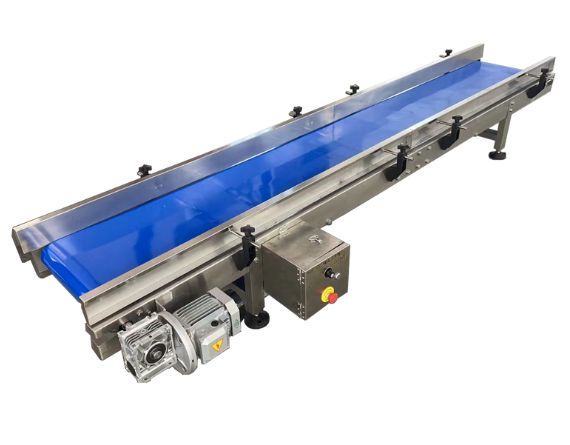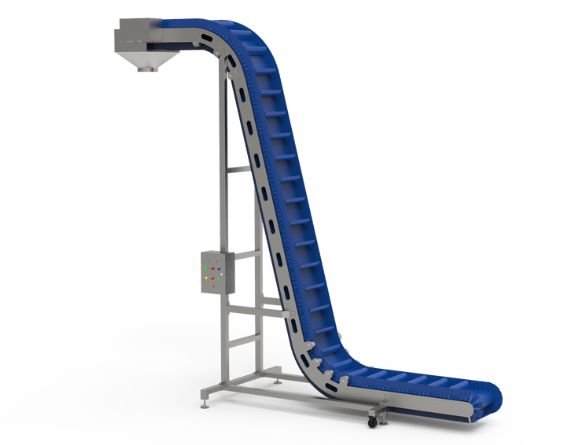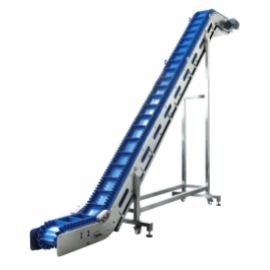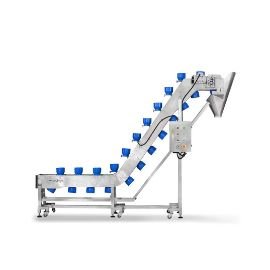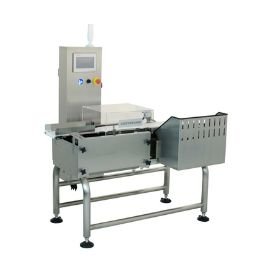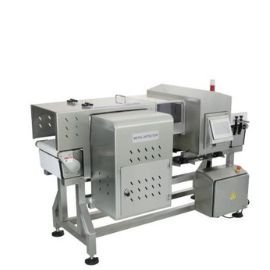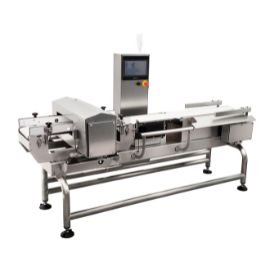Food Conveyor Belt Systems – Complete Solutions for Packaging, Processing & Integration
- Variety styles
- Customized design
- Attractive price
What is a Conveyor Belt? | Definition
A conveyor belt is a continuous moving surface used to transport products along a production line.
Driven by motorized pulleys, it works on the principle of friction drive, carrying items from loading point to discharge point with stable and efficient movement.
In the food industry, conveyor belts are essential for product handling, automated packaging, and processing lines, ensuring hygiene and consistency.
➡ What is a conveyor belt used for?
Moving raw materials
Transferring packed goods
Elevating or lowering products
Sorting and accumulation
Connecting machinery in a seamless flow
A conveyor belt is not just a moving platform. It’s a critical link in every automated production line.
How Do Conveyor Belts Work? (3)
Conveyor belts operate through a looped belt stretched over rollers and pulleys, driven by a motor.
Friction between the belt and the drive pulley moves the belt, transporting products along the desired path.
For specialized systems like curved conveyor belts, angled rollers or modular plastic links are used to allow smooth turns without product slipping.


Benefits With Our Belt Conveyor

Various sizes are adapted to different heights of transportion applications .various belt for selected according to materials .

When ensuring excellent quality ,our price is very attractive ,Our price is the best for the same quality .

we have sufficent materials in stock and rich production experience ,cargoes will be delivery at fasted speed .

Size and materials are not only,they can be selected according to customer need or actual applications
Conveyor Belt Types & Applications in the Food Industry
✅Flat Belt Conveyor
Simple, cost-effective solution for straight-line product transport.
Ideal for general food processing and packaging applications.
✅ Modular Belt Conveyors
Using plastic modular conveyor belts, these systems are durable, hygienic, and perfect for wet, oily, or abrasive products.
Widely used in seafood, meat, and vegetable processing.
✅ Cleated Conveyor Belts
Featuring vertical cleats to prevent product rollback on inclines.
Common in applications like powder transfer, grain handling, and snack packaging.
- Related terms: cleated conveyors, cleated incline conveyor, cleated belt conveyor design, cleated conveyor belt manufacturer
✅ Sidewall Conveyor Belts
With sidewall conveyor belts or side wall conveyors, materials are securely transported at steep inclines without spillage.
Perfect for loose, granular, or bulk food items.
- Related: corrugated sidewall conveyor belt
✅ Incline & Decline Conveyor Systems
Custom-built to move products up or down in elevation.
Used in compact production layouts and vertical transfers.
-
Related: incline conveyor systems, incline conveyor belt, incline conveyor belt types, incline conveyor belt for sale, decline conveyor
✅ Curved Belt Conveyors
Allowing smooth 30°, 45°, 90° turns in limited spaces.
Ideal for optimizing factory layouts.
-
Related: curved belt conveyors, curved conveyor belt, how do curved conveyor belts work
✅ Stainless Steel Belt Conveyors
For harsh environments requiring hygiene and durability.
Common in seafood, frozen food, and industrial baking lines.
-
Related: stainless steel belt conveyor, stainless steel conveyor belt manufacturers, stainless steel conveyor belt price
✅ Sandwich Belt Conveyor Systems
Specialized systems using two belts to grip and elevate products vertically.
Suitable for unique elevation and gentle handling applications.
-
Related: sandwich conveyor belt, sandwich belt conveyor system
✅ Easy Clean Conveyor
Designed with easy to detach & clean components, this conveyor is ideal for industries requiring strict hygiene standards, such as fresh produce, meat, seafood, and ready-to-eat foods.
Our easy clean conveyors feature tool-free disassembly, smooth surfaces, and optimized conveyor cleaning systems for fast sanitation cycles.
Whether you need a sanitary conveyor, a hygienic conveyor design, or an easy to clean conveyor solution, we provide systems that reduce cleaning time and increase production uptime.
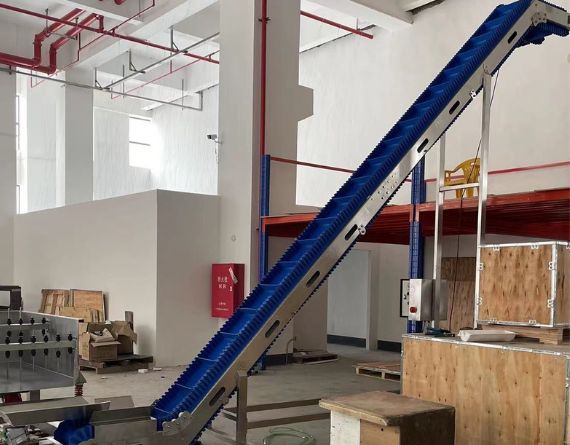

💰 Cost of Belt Conveyor – Flexible to Your Budget
The cost of a belt conveyor depends on configuration, material choice, and customization level.
We offer:
-
High-end solutions with premium materials (Yongli PU/PVC, Xinhai modular belts)
-
Cost-effective models with stable, reliable suppliers
-
SEW motors as standard
-
Best value through optimized design, not over-engineering
Whether you’re looking for top-tier performance or balanced cost-efficiency, we build conveyor belts that match your business needs.
Conveyor Belt Size & Customization
The size of a conveyor belt is determined by your product type, production capacity, and factory layout.
There is no one-size-fits-all solution—every project requires specific dimensions to ensure efficiency and smooth integration.
Key Factors:
- Product dimensions & weight: Larger or heavier items need wider, stronger belts.
- Throughput requirements: Higher capacity lines require wider belts or faster speeds.
- Factory space & layout: Limited space may call for compact conveyors, curves, or incline systems.
- Belt material choice: From PU, PVC, modular plastic to stainless steel—material impacts belt width, durability, and hygiene.
At Fill Package, we provide customized conveyor belt design, adjusting length, width, speed, and materials to fit your exact needs.
Whether it’s a flat belt for general transport, a modular plastic conveyor for heavy-duty use, or a hygienic easy-clean system, every size is tailored for your production.

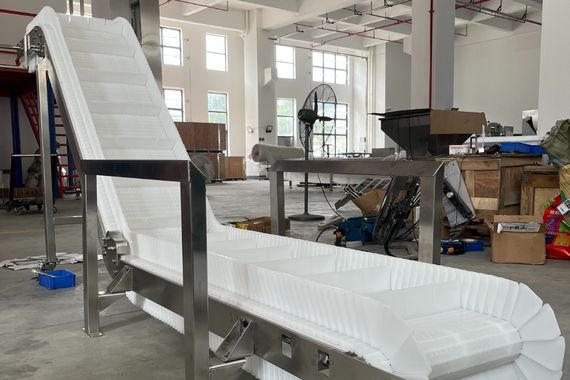
Why Choose Fill Package Conveyor Belts?
✅ Custom-built for food industry applications
✅ Top-quality materials from China’s leading suppliers
✅ Proven integration with global packaging machine brands
✅ Full-welded frames for superior durability
✅ Flexible designs for any layout: incline, curve, sidewall, cleated
✅ Reliable after-sales support & responsive service
✅ Most clients become long-term repeat customers
Fill&Package Conveyor Belt Advantage
All Fill Package conveyor belts feature enhanced frame reinforcement at stress points, reducing vibration and extending machine lifespan, even under continuous heavy-duty operation.
Our conveyor belts are designed with universal compatibility, ensuring smooth integration with international packaging lines from Europe, America, and Asia, minimizing modification costs for agents and integrators.
Related Product
Build Your Conveyor Belt Solution with Fill Package
Whether you’re an agent, integrator, or equipment manufacturer, our food conveyor belts provide the quality, customization, and value you need.
The cost of a belt conveyor depends on several key factors:
-
Belt type and material (PU, PVC, modular plastic, stainless steel)
-
Conveyor size (length, width, height)
-
Motor brand and power (SEW or other specified brands)
-
Structural design (standard frame vs. full-welded heavy-duty frame)
-
Customization level (cleats, sidewalls, curves, incline/decline angles)
-
Additional features (hygienic design, easy clean mechanisms)
A simple flat belt conveyor costs less, while a food grade, easy clean conveyor with custom incline and modular belt will be higher.
Conveyor belt size selection depends on:
-
Product dimensions & weight
-
Required throughput (capacity per hour)
-
Available factory space
-
Height difference (incline/decline needs)
-
Integration with existing machines
Our team provides custom sizing proposals to match your production layout and efficiency goals.
A sanitary conveyor (or hygienic conveyor) is designed for easy cleaning and quick maintenance in industries with strict hygiene standards (e.g., food, pharmaceuticals).
Key features include:
-
Tool-free disassembly
-
Smooth surfaces, no dirt traps
-
Open frame design for washdown
-
Conveyor cleaning systems for fast sanitation
-
Easy to detach & clean belts and components
These systems reduce downtime and meet food safety compliance.
-
Related: easy clean conveyor, conveyor cleaning system, easy to clean conveyor design
- Flat belt conveyors use continuous PU or PVC belts, suitable for general transport, simple layouts, and light to medium loads.
-
Modular plastic conveyors use interlocking plastic segments, offering higher durability, better drainage, and easier cleaning—ideal for wet, abrasive, or heavy products.
-
Related: flat belt conveyor belt, modular plastic conveyors, plastic modular conveyor belt
-
Cleated conveyors are used for inclined transport, preventing product rollback (e.g., grains, powders).
-
Sidewall conveyors (corrugated sidewall belts) are designed for steep inclines, keeping loose or bulk materials contained.
-
Related: cleated incline conveyor, sidewall conveyor belt, corrugated sidewall conveyor belt
Curved conveyor belts use modular plastic links or precision-driven rollers to change product direction smoothly.
They maintain product orientation and flow in compact factory layouts.
-
Related: curved conveyor belt, how do curved conveyor belts work
Stainless steel conveyor belts are corrosion-resistant, hygienic, and durable.
They are used in seafood, frozen food, baking, and harsh environment applications.
-
Related: stainless steel conveyor belt manufacturers, stainless steel conveyor belt price
Yes.
We specialize in custom conveyor solutions, including:
-
Incline & decline conveyors
-
Curved conveyors
-
Space-optimized designs
-
Conveyor belts sized and shaped to your layout
-
Specialized accessories (guides, hoppers, sensors)
Every system is designed based on your product and production flow.
-
Standard flat belt conveyors: 15–20 working days
-
Customized conveyors (incline, sidewall, modular plastic): 15–25 working days
-
Highly specialized systems (sandwich belts, complex curves): to be confirmed after design
We offer:
-
Full documentation (drawings, manuals)
-
Online technical support
-
Spare parts supply with transparent pricing
-
Long-term service partnerships
Our goal is to ensure smooth operation, fast problem resolution, and long-term cooperation.


